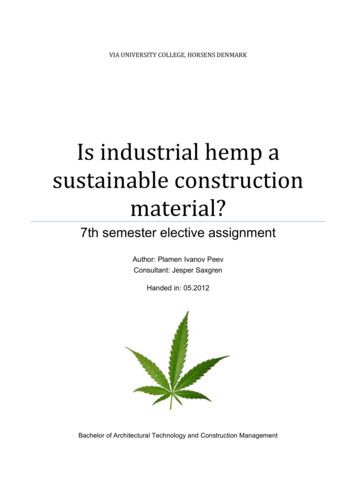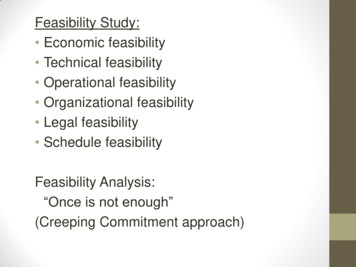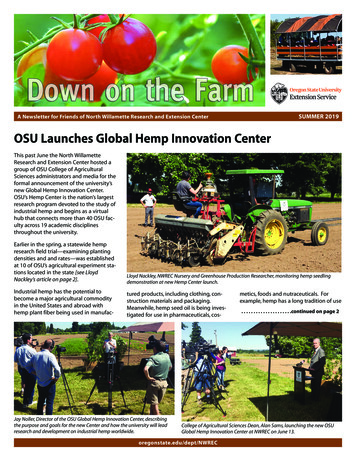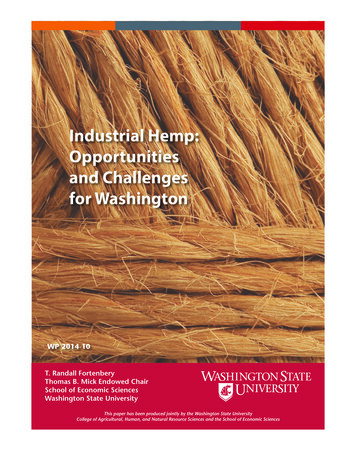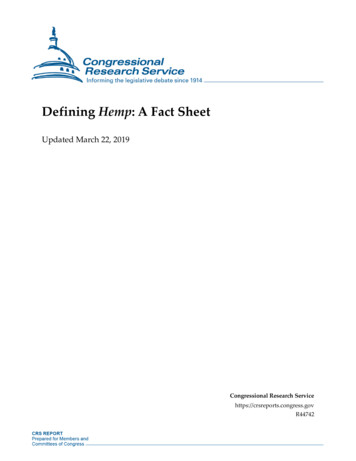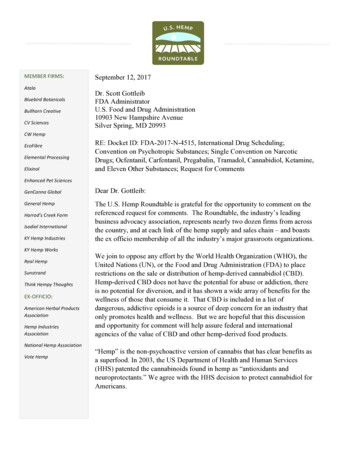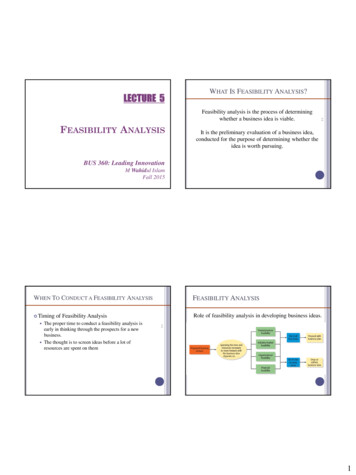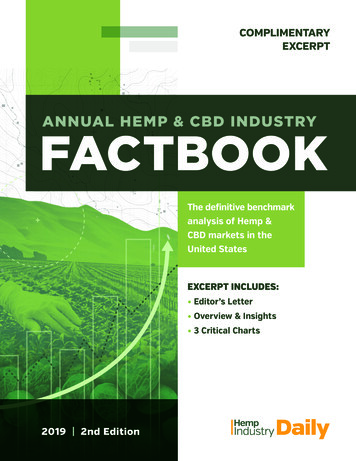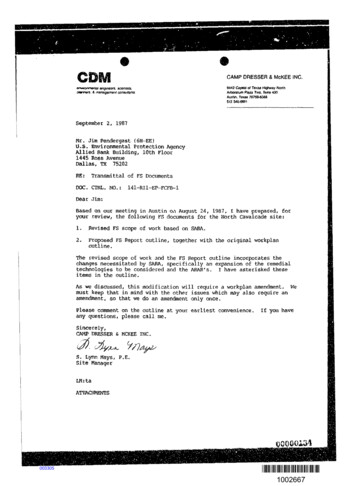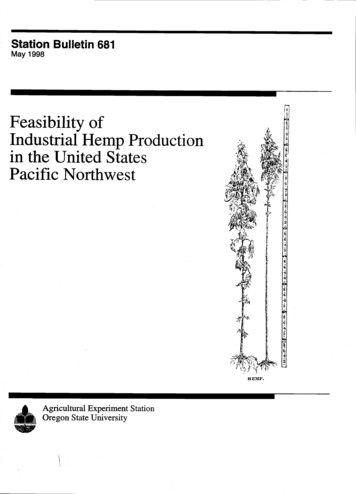
Transcription
Station Bulletin 681May 1998Feasibility ofIndustrial Hemp Productionin the United StatesPacific Northwest1LE1IP.Agricultural Experiment StationOregon State University
For additional copies of this publication, write:Publications OrdersExtension and Experiment Station CommunicationsOregon State University422 Kerr Administration Bldg.Corvallis, OR 97331-2119This report is printed on VanguardHemp, a product of the Living Tree Paper Company, Eugene, Oregon.It is 25 percent hemp, 25 percent cotton, and 50 percent post-consumer waste. The long fibers from hempsignificantly improve and extend the recyclability of the post-consumer waste paper.Cover: Hemp illustration from Oregon Agricultural Experiment Station Bulletin No. 54, May 1898,showing male (right) and female plants (left).
Agricultural Experiment StationOregon State UniversityStation Bulletin 681May 1998Feasibility ofIndustrial Hemp Productionin the United StatesPacific NorthwestDaryl 7'. EhrensingDepartment of Crop and Soil ScienceOregon State UniversityThis report was prepared and printed with support from the Oregon Natural Resources Council,the Turner Foundation, and the Wallace Genetic Foundation.
ic Importance:Adaptation:Climatic RequirementsMoistureSoilsAgronomy:Hemp VarietiesSeedbed Preparation and PlantingFertilizerWeed controlInsects, Diseases, and other pestsHarvestRettingFiber SeparationYieldTransport and StorageSeed ProductionClimate and Soils of the PNW:Possible Hemp Adaptation to the PNW:Hemp Production 415161720212324242628303436
FEASIBILITY OF INDUSTRIAL HEMP PRODUCTION INTHE UNITED STATES PACIFIC NORTHWESTSUMMARY:For many centuries hemp (Cannabis sativa L.) has been cultivated as a source of strong stemfibers, seed oil, and psychoactive drugs in its leaves and flowers. Environmental concernsand recent shortages of wood fiber have renewed interest in hemp as a raw material for awide range of industrial products including textiles, paper, and composite wood products.This report assesses the agricultural feasibility of industrial hemp production in the PacificNorthwest (PNW).Hemp is an herbaceous annual that develops a rigid woody stem ranging in height from 1 toover 5 meters (3 to 19 feet). Hemp stalks have a woody core surrounded by a bark layercontaining long fibers that extend nearly the entire length of the stem. Plant breeders havedeveloped hemp varieties with increased stem fiber content and very low levels of delta-9tetrahydro-cannabinol (THC), the psychoactive ingredient of marijuana.Historically, hemp fiber was used mainly for cordage, but it can also be made into textiles,paper, and composite wood products. Demand for hemp cordage peaked in the late 1800's,and world hemp production has continuously declined since that time, except for briefincreases during both World Wars. Hemp fiber has largely been replaced by relativelyinexpensive natural and synthetic fibers.Although hemp is well adapted to the temperate climatic zone and will grow under variedenvironmental conditions, it grows best with warm growing conditions, an extended frostfree season, highly productive agricultural soils, and abundant moisture throughout thegrowing season. When grown under proper conditions, hemp is very competitive withweeds, and herbicides are generally not required in hemp production. Although a number ofinsect pests and diseases have been reported on hemp, significant crop losses from pests arenot common. High levels of soil fertility are required to maximize hemp productivity.Cultural requirements and production costs are quite similar to those of corn. Reported hempyields range from 2.5 to 8.7 tons of dry stems per acre.The climatic and soil requirements of hemp can be met in some agricultural areas of thePNW, however, hemp will almost certainly require irrigation to reliably maximizeproductivity in the region. The requirement for supplemental irrigation will place hemp indirect competition with the highest value crops in the PNW, limiting available acreage. Stemyields will have to be substantially higher than those previously recorded for hemp to beeconomically feasible in the PNW at current prices. It is unlikely that the investment neededto improve hemp production technology will be made until legislative restrictions areremoved from the crop.1
INTRODUCTION:The decreasing availability and rising prices of local wood fiber resources have greatlyincreased commercial interest in agricultural production of alternative fiber sources in thePacific Northwest. Production of industrial hemp has been proposed as a viable source ofsubstitute raw material for a wide range of industrial products including paper and compositewood products. Although many popular publications have recently touted the revival ofindustrial hemp in the United States, a thorough analysis of the subject is essential to assessthe feasibility of industrial hemp production in the Pacific Northwest.Hemp (Cannabis sativa L.) has been grown for many centuries for the strong fiber producedin its stems. Hemp seed also contains a useful vegetable oil, and the upper leaves andflowers of some Cannabis varieties produce the psychoactive drug delta-9-tetrahydrocannabinol (THC), the active ingredient of marijuana. Although these plants belong to asingle species, the term hemp is often used to distinguish industrial fiber varieties from thedrug varieties of Cannabis. Some confusion arises from the use of the term hemp, since theword hemp is used in association with strong fibers from many unrelated species. Amongthe many species commonly referred to as hemp are Manila hemp from Musa textilis (abaca),sisal hemp from A gave sisalina (sisal), ambari hemp from Hibiscus cannabinus (kenaf), andsunn hemp from Crotalariajuncea (Robinson, 1953; Montgomery, 1954). This study isconcerned with true hemp, Cannabis sativa L.This report is an attempt to assess the agricultural feasibility of industrial hemp production inthe Pacific Northwest. The report will review the available literature on hemp botany,agronomy, and possible biological adaptation to the PNW. A preliminary analysis of hempproduction costs will also be presented. While it is theoretically possible to obtain a permitto grow Cannabis sativa in the United States, restrictions imposed by the federal governmenthave effectively prohibited production. This report will in no way attempt to deal with issuesconcerning Cannabis legalization.BOTANY:The hemp plant (Cannabis sativa L.) is an herbaceous annual belonging to the familyCannabinaceae. Among most botanists it is considered the only species in the genusCannabis. As the plants mature a rigid, woody stem develops ranging in height from 1 toover 5 meters (3 to 19 feet). Uncrowded plants have many spreading branches, and thecentral stalk can grow 30 to 60 millimeters (1 to 2 inches) in diameter. When grown in thickstands, hemp stems are unbranched and without foliage except near the top and range from 6to 20 millimeters (1/4 to 3/4 inch) in diameter. Stems of most varieties are hollow. Leavesare palmately compound with 5 to 11 pointed, serrate leaflets 50 to 150 millimeters (2 to 6inches) long and 10 to 20 millimeters (3/8 to 3/4 inch) wide (Dewey, 1913). In light, welldrained soils primary hemp roots can reach depths of 2 to 2.5 meters (6.5 to 8 feet), andsecondary root branches may grow 60 to 80 centimeters (2 to 2.5 feet) below the soil surface(Bocsa and Karus, 1998).2
Hemp nonnally is dioecious having both staminate (male) and pistillate (female) plants, eachwith distinctive growth characteristics. Staminate plants are tall and slender with few leavessurrounding the flowers, while pistillate plants are short and stocky with many leaves at eachterminal inflorescence (Figure 1.). Staminate plants senesce and die soon after their pollen isshed, while pistillate plants remain alive until the seeds mature. Relatively stablemonoecious varieties have been developed through breeding and selection.Figure 1. Pistillate (left) and staminate (right) hemp plants (Dewey, 1913).Hemp seeds are smooth, nearly spherical achenes which range in color from light brown todark gray and are often mottled. Seed size varies widely from 2.5 to 4 millimeters (1/10 to3/16 inch) in diameter and 3 to 6 millimeters (1/8 to 1/4 inch) in length (Dewey, 1913).Thousand seed weights range from 8 to 27 grams. Seeds of monoecious fiber varietiesaverage 16 grams per thousand while larger seeds from dioecious hemp average 21 grams perthousand (Dempsey, 1975). Hemp seeds usually contain from 29 to 34% oil. Hemp seed oilis similar to other common drying oils such as linseed, tung, and perilla and consistsprimarily of unsaturated fatty acids including approximately 54-60% linoleic (C 18:2), 15-20% linolenic (C18:3), and 11-13% oleic (C18:1) acid.r
Hemp stalks have a hollow woody core surrounded by the vascular cambium (the growingtissue) and an outer ring of cells consisting of phloem, cortex, and epidermal tissue (the bark)(Figure 2). Fiber cells develop in bundles associated with the phloem (or bast).Figure 2. Hemp stems showing bark, secondary bast fibers,and woody core (De Meijer, 1993a).Hemp produces both long, coarse fibers which extend nearly the entire length of the stalk(primary bast fibers) and short, fine fibers which tend to adhere to the woody core (secondarybast fibers). Individual hemp fiber cells range from 0.20 to 2.16 inches (5 to 55 mm) longand 0.0 16 to 0.05 mm in diameter and are arranged in bundles to form the primary andsecondary fibers (Montgomery, 1954). The proportion of bark in hemp stems varies from 14to 48% depending on the genotype and plant height (Van der Werfet al., 1994).ifiSTORY:Although some authors contend that hemp originated in central Asia, most now agree thatChina was the original home of hemp (Dewey, 1913). Because the greatest diversity of hempgermplasm is found there, Vavilov placed the center of origin of hemp in China (Vavilov,1992).
Cultivation and use of hemp for fiber predates written history. Chinese writings from theSung dynasty (about 500 A.D.) state that the emperor Shen Nung first taught the people ofChina to cultivate hemp and make cloth around 2,800 B.C. Later Chinese texts indicate thathemp stalks were also used for fuel and the seeds for food and oil, but there are no earlyrecords of hemp production for drug use in China. According to Herodotus (about 450 B.C.)hemp fiber was used by the Thracians and Scythians beyond the Caspian Sea and wasprobably introduced to Europe during the westward Scythian migration around 1500 B.C.Hemp remained virtually unknown to the Greeks and Romans, however, until the beginningof the Christian era (Dewey, 1913). The earliest written record of hemp use in Europe statesthat "Heiro II, King of Syracuse (270 B.C.), bought the hemp used for the cordage of hisvessels in Gaul" (De Candolle, 1886). By the sixteenth century hemp was widely distributedin Europe where it was cultivated for fiber and the seeds were cooked with barley or othergrains and eaten. In 1537 Discorides named the plant Cannabis sativa and wrote of its usefor cordage as well as its medicinal properties (Dewey, 1913),As early as 1545 hemp was brought to the Western Hemisphere by the Spaniards who begancultivation in Chile (Husbands, 1909). Hemp was introduced to the United States in 1645 bythe Puritans in New England as a fiber source for household spinning and weaving, but neverbecame as important as flax in the region. Cultivation spread to Virginia and was wellestablished in Pennsylvania before the American Revolution (Dewey, 1913). Hemp wasbrought to Kentucky in 1775 by settlers from Virginia and grew so well that a commercialcordage industry developed in Kentucky that lasted long after hemp cultivation wasabandoned in the eastern states (Humphrey, 1919). The hemp industry flourished inKentucky, Missouri, and Illinois between 1840 and 1860 due to strong demand for sailclothand cordage, however, large imports of cheaper jute and abaca eventually displaced mostdomestic hemp (Dodge, 1897; Dempsey, 1975). With development of the cotton gin, thehemp industry quickly declined as cotton production rapidly increased in the South. Growthof the cotton industry did provide demand for hemp cordage and bagging to package cottonbales until iron ties were introduced in about 1865 (Dewey, 1913; Humphrey, 1919). Duringthe late 1800's and early 1900's hemp production was tried in many other states, but from theend of the Civil War until 1912 virtually all hemp in the United States was produced inKentucky (Wright, 1918). Domestic hemp production revived slightly in response to WorldWar I, and fiber hemp was grown in several states including Kentucky, Wisconsin,California, North Dakota, South Dakota, Minnesota, Indiana, Illinois, Ohio, Michigan,Kansas, and Iowa (Wright, 1918; Dempsey, 1975).There are no records that hemp was ever a commercial crop in Oregon, however,experimental crops were attempted in the 1890's (French, 1898) and in the 1930's. USDAresearchers B.B. Robinson and E.G. Nelson planted many hemp trials in Oregon during the1930's as part of an ongoing fiber crop research project. This included trials with highyielding varieties developed by the USDA such as Kymington, Chinamington, and Chington(Robinson, 1934; Robinson, 1935b; Robinson, 1936). In addition, a hemp breeding andselection program was established in Corvallis, Oregon to develop and test advanced lines.Results from the non-irrigated production trials were generally very poor with many cropfailures due to lack of rainfall. Because of unsatisfactory crop performance and climatic5
conditions, the USDA hemp project based in Oregon and all seed produced were transferredto Madison, Wisconsin in 1937 (Nelson, 1937).In 1937 the U.S. government passed the Marijuana Tax Act which placed all Cannabisculture under control of U.S. Treasury Department regulations. This act required theregistration and licensing of all hemp growers with the federal government in an effort torestrict production of psychoactive Cannabis varieties in the United States. Additionallegislation established penalties for production, sale, and possession of marijuana and hashish(Dempsey, 1975). Although many other countries also prohibited Cannabis cultivation,hemp production was not restricted in much of Asia, South America, eastern Europe, and inseveral countries in western Europe.When World War II interrupted supplies of jute and abaca to the United States from thetropics, an emergency program was undertaken to quickly develop hemp as a domesticallyproduced substitute. A special division of the USDA Commodity Credit Corporationcontracted production of hemp planting seed and fiber. War Hemp Industries, Inc.constructed a number of hemp fiber processing mills in the midwest. Domestic hempproduction peaked during 1943 and 1944 and declined rapidly after the war as legalrestrictions on production were increased and supplies of inexpensive tropical fibers werereestablished. A small hemp fiber industry continued in Wisconsin, however, until 1958.Fiber hemp production in the United States has been negligible since that time (Ash, 1948;Dempsey, 1975).ECONOMIC IMPORTANCE:Because of their strength and durability, hemp fibers have been used for production ofcordage and coarse textiles for centuries. In addition, hemp can provide raw material for pulpand paper manufacture, composite wood products such as particleboard and insulation board,and industrial products including geotextiles and nonwoven industrial fabrics. Hempcurrently provides less than one percent of total world production of vegetable fibers (Table1.) (FAO, 1996).Use of hemp for marine cordage was largely replaced by abaca in the 1800's because abacaropes are lighter and will float in water, are more resistant to damage from salt water withoutbeing tarred, and are less expensive than hemp due to lower labor costs in the tropics (Ash,1948; Robinson, 1953; Dempsey, 1975). Relatively inexpensive synthetic (polypropylene)and natural (sisal) fibers have occupied most of the agricultural twine markets formerlyserved by hemp.Hemp textile production is based primarily in Asia and central Europe. Korea has a longhistory of hemp fabric production, primarily for use as domestic clothing (Ree, 1966). InItaly, Hungary, and adjacent countries, water-retted fiber is prepared with great care toproduce relatively fine yams and soft fabrics resembling flax (Montgomery, 1954). Theseyarns and cloth are quite expensive compared to natural and synthetic fiber blends made6
from competing fiber sources largely due to the amount of hand labor involved in theirproduction. A small novelty market based on hemp textiles imported from China andHungary has been developing in western Europe and the United States since the late 1980's.Table 1. World Production of Vegetable Fibers in 1,000 metric tons, ,59722,15123,69224,74923,752Cannabis HempTotal1992Although many people are surprised to learn that paper can be made from nonwood fibers,wood-based papermaking is a comparatively recent development. Not until the midnineteenth century was the technology developed for converting wood into pulp suitable forpaper. Hemp has a long history of use in papermaking and has normally been used toproduce strong, thin specialty papers similar to those made from flax (Hurter, 1989).Traditionally, hemp fiber has been viewed as an inexpensive substitute for flax in paperproduction, however, in France hemp prices have been depressed by the availability of largequantities of flax tow, a byproduct of the fiber flax textile industry (Van der Werf, 1992).Woody hemp core has been shown to produce a mechanical pulp similar to those made frompoplar (Dewey, 1913; Lewis et al., 1948; Bosia, 1975). Because hemp bark and core differconsiderably in fiber length and chemical composition, they are generally processedseparately to produce paper pulp. They also have very different market value. In 1992 theFrench market price for dry hemp bark was 2500 FF/metric ton (about 500/ton), while hempcore was worth only 250 FF/metric ton (about 50/ton) (Van der Werf, 1994). Since it haslong been evident that forest resources may not be sufficient to supply the expanding pulpand paper industry, several studies have been undertaken to explore agricultural production ofpulping fibers, including hemp (Nieschlag et al., 1960; Wood, 1981). In addition, there hasrecently been considerable increase in research activity on hemp pulping (De Groot et al.,1994; Laith et al., 1995; Van der Werfet al., 1994; Zomers et al.,1996). In the European andU.S. markets a number of companies are currently selling paper containing a minorpercentage of hemp fiber (bark fiber), usually blended with other, less expensive agricultural7
residues. These have gained some market acceptance as ecologically friendly or "tree-free"products, but are at present considerably more expensive than wood-based paper. Largerscale production of hemp paper will undoubtedly lead to lower production costs.Commercial manufacture of composite panelboard began early in this century. In bothEurope and the United States, this industry was developed to use not only wood fiber but alsoa wide range of agricultural residues such as sugarcane bagasse, flax shives, corn stalks, andcereal straw. As a result, many of the technical details associated with making panels fromagricultural fibers have been well known for decades (Atchison and Collins, 1976; Verbestel,1978). Commercially acceptable three layer particleboards can be produced from woodyhemp core using conventional equipment. Between 1950 and 1976 Siempelkamp & Co.(Krefeld, Germany) designed and built four particleboard plants using hemp core as theirfeedstock (Niedermaier, 1976). Production of composite panels from hemp or otheragricultural fibers is largely a matter of economics and availability of raw materials.Because of its low cost and availability in large quantity, wood fiber has long dominatedpaper pulp and composite panel production in North America and Western Europe, whileagricultural fibers have only been important in countries with limited wood resources. Woodchip and sawdust prices in the PNW are extremely volatile and respond quickly tofluctuations in local and international wood fiber supply. Local prices range from less than 50 to over 100 per dry ton. A long-term trend of increasing wood fiber prices has beenevident, however, for many years.Recent shortages of wood fiber in the United States and the resulting high prices haverenewed commercial interest in supplementing wood-based production with agriculturalfibers from a variety of sources. Agricultural residues from cereal and grass seed productionare widely available in the PNW in large quantities and at relatively low cost. Considerationof large-scale hemp production should also include analysis of the cost, availability, andperformance of these inexpensive competing raw materials.Another response to the price spike for wood fiber was the importation of large amounts ofwood chips and logs from Canada, Siberia, and South America as softwood chip prices in thePNW exceeded 100 per ton. Large acreages of natural and plantation forests exist in theseareas, and wood imports to the PNW can be increased rapidly in response to high marketprices. Although cutting these offshore timber resources on a large scale is probably notsustainable over long periods of time, the availability of these resources may makedevelopment of fiber crops for commodity uses more difficult by placing a ceiling on woodfiber prices.Woody core from hemp stems is highly absorbent material, and hemp core has beenmarketed as animal bedding and as an absorbent for oil and waste spill cleanup, It is alsoused in mixtures with lime and cement as a lightweight building material.Historical and current estimates of the cultivated area planted to hemp are presented in Table2 (FAO, 1996). For many years, until its breakup in 1991, the Soviet Union was, by a wide8
Table 2. Estimated Area in Hemp Cultivation 1910 to 1996 in 1000 ha.Year or PeriodRegion191019251948-52 1969-71 117 1185 118 118 118 1AsiaChinaJapanN. KoreaS. ussian Fed.SpainUkraineUSSRYugoslavia23314463791411264336 10003346666000 10 110 I 100 1230 1 10 1 10 1140141633642635502896537858156000000000002221313 1131165 132 646363S. AmericaChileN. AmericaWorld Total86510919
margin, the largest producer in the world followed by Italy, Romania, Hungary, Yugoslavia,and Poland. The People's Republic of China is probably the largest current producer ofhemp fiber, however, reliable figures on fiber hemp production in China are difficult toobtain. Although hemp production increased briefly during both World Wars in response toreduced availability of other fibers, production of hemp has continuously decreased since thattime, particularly in countries with market economies. Decreased hemp production is alsoevident in countries where Cannabis production has not been limited by law such as Korea,China, Chile, eastern Europe, and France. This decrease occurred despite the fact that worldtrade of hemp fiber or finished products has not generally been restricted by law or unusualtariffs. In these regions hemp production decreased presumably because it could not competeeconomically with other lower priced raw materials or because growers could realize greatereconomic returns from other crops.In 1988 the European Economic Community established subsidy payments for production ofhemp seed in EC countries (Anon., 1988). In 1989 the EC established a direct subsidyprogram as well as rules covering production of fiber hemp production (Anon., 1989). Theserules require registration of the area to be planted in advance, the use of seed from certifiedlow-THC varieties, and testing of fields to determine THC content. Despite the inducementof substantial and direct subsidy to producers of approximately 400 per acre, no majorincreases in EC hemp production have been reported to date. Today hemp survives as arelatively minor crop in western Europe where only a few thousand hectares are grownannually. Western European hemp production is currently profitable only because of ECsubsidies (Bocsa and Karus, 1998). Hemp production in France for the specialty papermarket has remained relatively stable in recent years at about 6,000 hectares per year. Sincethe early 1990's hemp has also been produced on a small commercial scale in theNetherlands and southern England (approximately 1,500 ha per year), and experimentalplantings have been made in other western European countries. Unfortunately, productionestimates from these areas do not yet appear in international agricultural production statistics.Current hemp development efforts in Western Europe include government and EC backedresearch programs in France, the Netherlands, and Germany. France has had an ongoingresearch program carried out by the Federation Nationale des Producteurs de Chanvre(FNPC) based near Le Mans for many years (Van der Werf', 1992). Since 1987 the Dutchgovernment has supported active research on the feasibility of fiber hemp production in theNetherlands including germplasm collection and research on agronomy, crop physiology,plant breeding, harvesting, and pulping tests. Both of these programs are intended to explorethe use of hemp as a nonfood crop for EC growers and a renewable raw material for pulp andpaper production.In the last several years small-scale experimental production of hemp hs also been allowedunder permits in Canada and Australia. Recently the Canadian government announced thatcommercial production of industrial hemp will be allowed in Canada beginning in 1998under a permit system similar to the one used in Western Europe.10
ADAPTATION:Climatic RequirementsHemp is well adapted to the temperate zone and will grow under a wide range ofenvironmental conditions. Hemp grows best when mean daily temperatures are between 13 and 22 C (6Oo800 F), but will endure colder and warmer conditions. Hemp grows quite wellat relatively low temperatures, and young seedlings will tolerate some exposure to frost.Because of this, hemp can be planted earlier than corn in most areas and will develop aclosed canopy early in the season allowing increased light interception and rapid growth(Van der Werfet al., 1995a). The best fiber producing hemp varieties require about 4 monthswithout killing frost to produce fiber and about 5.5 months to mature seed (Dewey, 1913).MoistureHemp requires abundant moisture throughout the growing season, particularly while youngplants are becoming established during the first six weeks of growth (Dewey, 1913). Afterthey are well rooted, plants can endure drier conditions, however, severe drought hastensmaturity and produces dwarfed plants. Studies in Europe indicate that hemp requires 500700 millimeters (20-28 inches) of available moisture for optimum yield, and that 250-300millimeters (10-14 inches) of moisture should be available during the vegetative growthstage. These amounts include both precipitation and available soil moisture. In Europehemp yield is strongly dependent on the amount of rainfall during June and July (Bocsa andKarus, 1998). Crop water use will, of course, vary depending on local soil, climatic, andcultural conditions.Hemp has been grown successfully under irrigation in Turkey, Spain, and Chile (Dempsey,1975). Since large-scale hemp production has generally been centered in areas withsignificant rainfall during the growing season, very little information is available regardinghemp irrigation.Hemp is quite sensitive to soil moisture conditions. While hemp grows well on soils withhigh water-holding capacity, good soil drainage is also important to maximize hempproduction. Commercial hemp fields grown in Iowa, Illinois, Minnesota, and Wisconsin in1943 and 1944 had uneven growth and lower yields in slow-draining soils, and hempplantings often failed or were abandoned in poorly drained fields (Vessel and Black, 1947).SoilsAlthough it can be grown on a variety of soil types, hemp does best on loose, well-drainedloam soils with high fertility and abundant organic matter (Dempsey, 1975; Van der Werf,1991). Hemp should not be grown on poor soils (Robinson, 1952). Repeated attempts tocultivate hemp on heavy, low-lying soils have demonstrated that, while these soils mayproduce some large hemp plants, it is practically impossible to raise a good, even stand ofhemp stalks that produce high quality fiber. "In Texas good crops of hemp have been11
produced on rich dark prairie soil, but on upland soils, subject to drought, the crop has proveda failure" (Dewey, 1901). "Fertile clay loam or silt loam soils, neutral or slightly alkaline,are best for hemp. It will not grow well in acid sandy soils, heavy clay, or gumbo soils, orgravelly soils that thy out quickly. On peaty marshlands the plants may grow large, but thefiber will be small in quantity and poor in quality" (Dewey, 1913). The most productive soilsin the U.S. Corn Belt were recommended to maximize hemp production (Robinson, 1952).Optimum soil pH for hemp production ranges from 5.8 to 6.0 (Bocsa and Karus, 1998).AGRONOMY:General agronomic practices for hemp production are well known and will be summarizedbelow. Several extension publications were p
Oregon State University Station Bulletin 681 May 1998 Feasibility of Industrial Hemp Production in the United States Pacific Northwest Daryl 7'. Ehrensing Department of Crop and Soil Science Oregon State University This report was prepared and printed with support from the Oregon Natural Resources Council,
